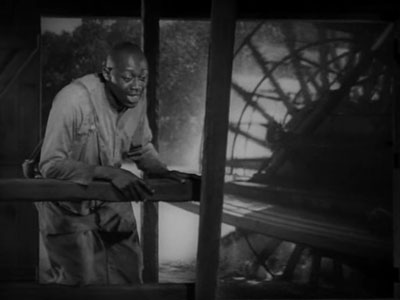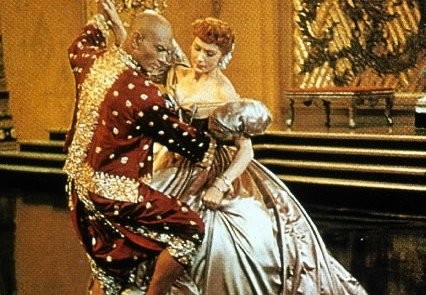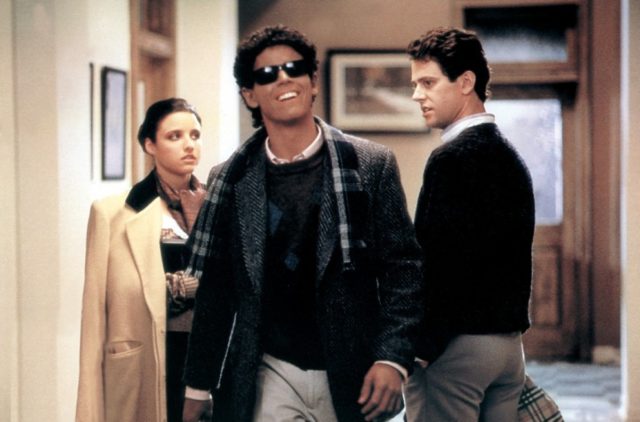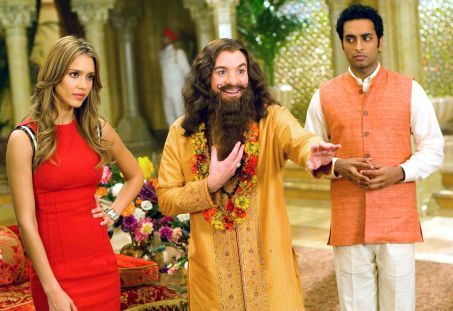With the release of 2013’s The Lone Ranger, audiences were treated to the latest in a long line of demeaning and politically incorrect depictions of an ethnic minority by Hollywood: Johnny Depp in red-face. From its earliest days, Hollywood populated its films with vicious racial caricatures that disenfranchised people of color by casting white actors as members of other races. Below are ten of the most egregious examples of politically incorrect filmmaking during the classical era of the Hollywood studio system.
10. Steamboat Round the Bend (1935)
Actor Stepin Fetchit may have been the subject of recent re-evaluations that have suggested that his oeuvre may have been more subversive than he was originally given credit for, but his infamous onscreen persona as a lazy, shiftless, borderline-retarded black man was one of the most damning and cringe-worthy creations of classic Hollywood.
In truth, almost any film he appeared in could have had grounds for inclusion on this list, but we’re going with with John Ford’s Steamboat Round the Bend for a couple of reasons. First, Fetchit was a regular member of Ford’s early stable of actors, appearing in many of the man’s films. Second, whereas many of their collaborations, such as Judge Priest and The Sun Shines Bright, utilized Fetchit’s persona in order to condemn racist undercurrents in American society, there is almost no justification for Fetchit’s actions in Steamboat Round the Bend. He shows up, does his hokum shtick, and sticks around almost purely for comedic relief.
9. The Good Earth (1937)
Irving Thalberg’s adaptation of Pearl S. Buck’s Pulitzer Prize-winning The Good Earth may have been born of the best of intentions, but the resulting film was awash in stereotypes and actors in yellowface. Buck had wanted the film to be made with all Chinese or Chinese-American actors, but Thalberg cast Paul Mini for the lead role.
Chinese-American actress Anna May Wong was considered for the role of Mini’s wife, but the Hays Code’s anti-miscegenation rules made it impossible, forcing the two lead characters of the film to be played by white actors in yellowface. In fact, special techniques were created by legendary make-up artist Jack Dawn to make the slew of Western actors used in the film look ethnically Chinese.
8. Babes in Arms (1939) / Babes on Broadway (1941)
We’re lumping these two films together as one entry because they’re remarkably similar to each other in terms of performers, plot, and ethnic stereotypes. Both films follow Mickey Rooney and Judy Garland as wanna-be performers who join forces to put on their own show. The plots of both films are relatively sparse, devoting most of their run times to energetic song-and-dance numbers.
And while most of these films’ production numbers are charming and non-offensive, both end with massive minstrel show set-pieces where almost the entire cast (Rooney and Garland especially) rub their faces with burnt cork and enact some of the most cringe-worthy blackface stereotypes to ever grace the big screen. While both films feature extensive blackface routines, Rooney goes the extra mile in Babes on Broadway by doing a very “enthusiastic” Brazilian dance number in drag, à la Carmen Miranda.
7. Little Tokyo, U.S.A. (1942)
Otto Brower’s Little Tokyo, U.S.A. is nothing short of despicable anti-Japanese propaganda. The fact that it was made and distributed by a studio as massive as 20th Century Fox is even more astonishing.
The film follows Los Angeles policeman Michael Steele as he uncovers an underground ring of Japanese saboteurs. Incredibly, it seriously suggests that nearly the entire population of Japanese-Americans in Los Angeles are collaborators and that the internment of their real-life counterparts is essential for the security and welfare of the United States.
6. Song of the South (1946)
Notorious for its romanticized depiction of Reconstruction-Era Georgia, complete with an ever-cheerful ex-slave with magical powers named Uncle Remus, Disney’s Song of the South has yet to be released on home video in the United States. A combination of live action footage and animation, the film was a collection of African-American folk tales as told by the aforementioned Uncle Remus to a couple of children whose grandparents were plantation owners. Famous folk tale characters like Br’er Rabbit, Br’er Fox, and Br’er Bear show up to act out stories in a film which seems insensitive at best, horrifically offensive at worst.
A statement released by the NAACP explained: “The production helps to perpetuate a dangerously glorified picture of slavery. Making use of the beautiful Uncle Remus folklore, “Song of the South” unfortunately gives the impression of an idyllic master-slave relationship which is a distortion of the facts.”
5. The Conqueror (1956)
Dick Powell’s The Conqueror contains one of the grossest casting miscalculations in Hollywood history: John Wayne as Mongol emperor Genghis Khan. A big-budget epic about Genghis Khan’s rise to power, the film not only contains legions of white actors in yellowface, but it also contains very questionable sexual politics. The film seems to celebrate scenes where Genghis Khan forces himself on women, particularly Bortai, the kidnapped daughter of the Tartar leader. Producer Howard Hughes was reportedly so ashamed of the film that he spent $12 million to purchase all of the copies.
4. The King and I (1956)
Banned in Thailand, Walter Lang’s adaptation of Rodgers and Hammerstein’s The King and I has been accused of promoting a warped image of King Mongkut of Siam as an arrogant, ignorant tyrant. Additionally, Yul Brynner’s casting as Mongkut was insensitive because, despite his Eurasian heritage, he was not of Thai descent. Combine that with the general theme of the story (a Western woman “civilizing” an Asian ruler), and you have one of the most politically incorrect musicals of the 1950’s.
3. Breakfast at Tiffany’s (1961)
The reason why Blake Edwards’ adaptation of Truman Capote’s novella Breakfast at Tiffany’s is remembered as one of the most politically incorrect films of all time can be summarized in two words: Mr. Yunioshi. Played by actor Mickey Rooney (in yellowface), I.Y. Yunioshi was a cantankerous neighbor of protagonist Holly Golightly who pops up from time to time to flail about and shout racist dialogue. Although Edwards, Rooney, and producer Richard Shepherd have since apologized for the character, Mr. Yunioshi will forever be remembered as one of the most insulting characters in cinematic history.
2. Soul Man (1986)
Years before Robert Downing Jr. wore blackface in Tropic Thunder (2008), Hollywood made another film which tried to make comedy out of a white character wearing blackface: Steve Miner’s Soul Man. The film follows a rich young man who takes “tanning pills” to appear black so he can qualify for a scholarship to Harvard available only to African-American students.
The film was attacked and protested by the NAACP which released a statement saying: “”The film makes fun of the things we have to struggle with every day: the jokes, the hassles, the preconceptions and the demands. That notion itself–that some white kid can take a bunch of ‘tanning pills’ and all of a sudden understand all the things we have to deal with–is very offensive to us.”
1. The Love Guru (2008)
Parody is very difficult to pull off correctly. In some movies like Blazing Saddles (1974) and Airplane! (1980), racial stereotypes are evoked and deliberately made fun of. But in the case of Marco Schnabel’s The Love Guru, a Mike Myers vehicle where he plays the “eccentric” Indian Guru Maurice Pitka, the use of racial caricatures can horrifically backfire and result in a movie that is insulting to otherwise marginalized ethnic groups in America. For example, Ben Kingsley, the actor who won an Oscar for his title role in Richard Attenborough’s Gandhi (1982), was brought in to play an insulting Hindu stereotype as Guru “Tugginmypudha.” Before the film was even released, it drew ire from the Hindu American Foundation and many Hindu American leaders.










4 Comments
With hindsight, the most politically incorrect movies, literally, could be Rambo III and James Bond’s The Living Daylights.
Both movies show the Taliban and Al Qaeda as the good guys and the Soviets as the archetype baddies, while the events of 9/11 and many tragedies since, have shown that either the Soviets might have been on to something in a very early stage.
Or even, as several historians have indicated: The financial and military support by the western powers of muslim fundamentalism in Afghanistan during the 80-ties has been instrumental to the rise of the present day instability of the whole Middle East and Northern African region and the waves of fundamentalist terror striking the whole world.
Good list, but I’d add the James Bond movie YOU ONLY LIVE TWICE where Sean Connery is made up with a bad wig and eye makeup to disguise himself as a Japanese man.
http://youtu.be/G-Uf01YgSB4
Is it lonely up there on your high horse, Nate?
Two notes…
1. I’m getting really sick of Song of the South being portrayed as a film about slavery and slaves. Even in the description above, it’s described as existing in the Reconstruction-Era South. Reconstruction, as in, after the Civil War and after all the slaves were freed. These aren’t people existing in a master-slave world… they’re people who are freed from their bonds. THAT’S why they’re happy… if I was a 60-year-old slave who’d recently been freed, I’d be singing “Zip-a-Dee-Doo-Dah”, too…
2. No list of these movies is complete without Blazing Saddles. Politically incorrect to the hilt, but done so more expertly and satirically than any film before or since.